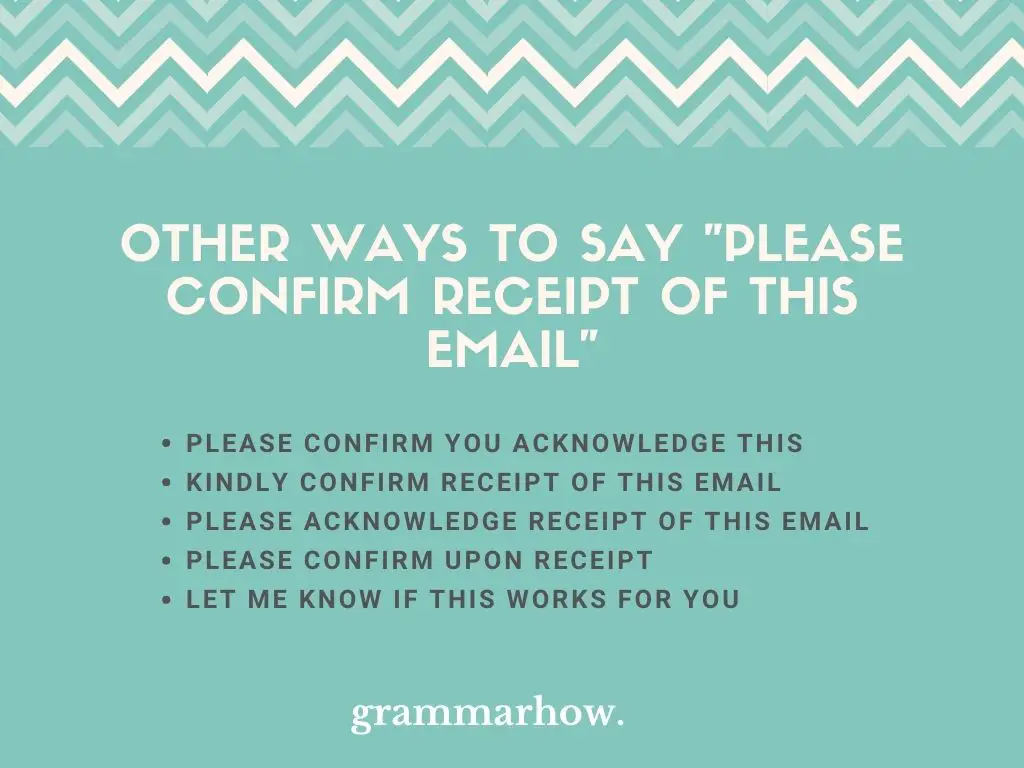
Coming up with another way to say “please confirm receipt of this email” helps people to acknowledge formal emails. It shows that you’ve read and understood something. This article will look into how to write an email asking for confirmation of receipt. These are the best options:
Other ways to say “please confirm receipt of this email” are “please confirm you acknowledge this,” “kindly confirm receipt of this email,” and “please acknowledge receipt of this email.” These synonyms are great to show you how to politely confirm receipt of an email.

When it comes to knowing what to say instead of “please confirm receipt of this email,” it doesn’t get much better than this phrase.
“Please confirm you acknowledge this” is a great phrase for formal emails. It shows that you would appreciate someone’s confirmation that they’ve received the email you sent to them.
It works best when dealing with sensitive information or information that needs someone’s attention.
“Kindly confirm receipt of this email” shows that you expect someone to respond to you when they have read and understood your email. “Kindly” is used to remain polite in this formal sentence.
“Confirm” is great to use here because it shows you expect confirmation as soon as someone reads your email. If they don’t respond, it suggests they do not know what you’re talking about.
This phrase is great to use in formal contexts. It shows that you want acknowledgement from someone upon receiving the email you sent them. “Please acknowledge” is a calm and polite tone used in formal emails.
It shows that you would appreciate someone’s confirmation. It also suggests that you don’t mind waiting a little bit before they give it to you.
“Please confirm upon receipt” is a simple phrase you can use formally. It shows that you expect confirmation from someone when they receive an email.
“Please” is used instead of “kindly” here (in “kindly confirm”). Both phrases are polite, allowing you to use either option, depending on your preference.
“Let me know if this works for you” is a decent alternative for this context. It works best when you’re uncertain about the response you might receive and would like someone to confirm whether something “works” for them.
It’s most common to use this one when addressing superiors. It shows that you don’t want to undermine them and want to maintain a respectful tone with them.
“Please respond” is a subtle demand that works well in formal emails. You should use it when you want someone to respond as soon as they read your email. It’s best to use it when you are a boss and rank higher than the recipient.
“Please respond” is best for bosses because it shows you have authority over someone. It commands them to “respond,” even if they don’t want to.
This phrase works well to show that you expect someone to “confirm” the receipt of an email upon reviewing it. It lets them know that you expect a response.
If they do not respond to your email, it suggests they either do not agree or do not understand the content.
This phrase is great to include in a formal capacity. It shows that you’d like someone to acknowledge the email you sent them. It implies that there’s something important for them to agree to.
“Acknowledge” is used again here to show that someone has an understanding of something. If they don’t “acknowledge” your email with a reply, it suggests they don’t know what you’re asking of them.
“Please confirm the receipt of this email” is a simpler term that works well formally. It shows that you’d like someone to confirm they have received the email by replying to you.
“Confirm” is a simple term. It works well in formal contexts, and it’s the best choice if you’re not sure what else to say in situations like this.
“Please confirm upon receipt” is another great alternative. It shows that you expect confirmation from the recipient when they email you. This suggests that they do not “confirm” your email until they reply to it.
Some people might forget to reply to an email. However, if you’ve specifically asked for their reply upon receipt, not replying means that they do not “confirm” something and don’t agree with you.
“Kindly respond as soon as you can” shows that you expect a response when someone is able to give you one. “Kindly” reinforces the politeness of the phrase while also demanding that someone “responds” as soon as they get the chance.
“Please confirm receipt of this email” means you would like someone to confirm they’ve read and understood your email. It works best formally when providing useful information or something that requires everyone to respond.
It’s common to see this when a boss sends an email to all their employees. It might request their presence for a company-wide meeting at a given time. They will ask for people to confirm their receipt of the email to ensure everyone has read it.
This allows the boss to check that everyone can make the listed time. If anyone has any issues, they’ll be able to sort it out after responding to the email directly.
If you’d like to know what to reply to this phrase, have a look at our article that shows 10 Formal Replies to “Please Confirm Receipt of This Email”
Martin holds a Master’s degree in Finance and International Business. He has six years of experience in professional communication with clients, executives, and colleagues. Furthermore, he has teaching experience from Aarhus University. Martin has been featured as an expert in communication and teaching on Forbes and Shopify. Read more about Martin here.